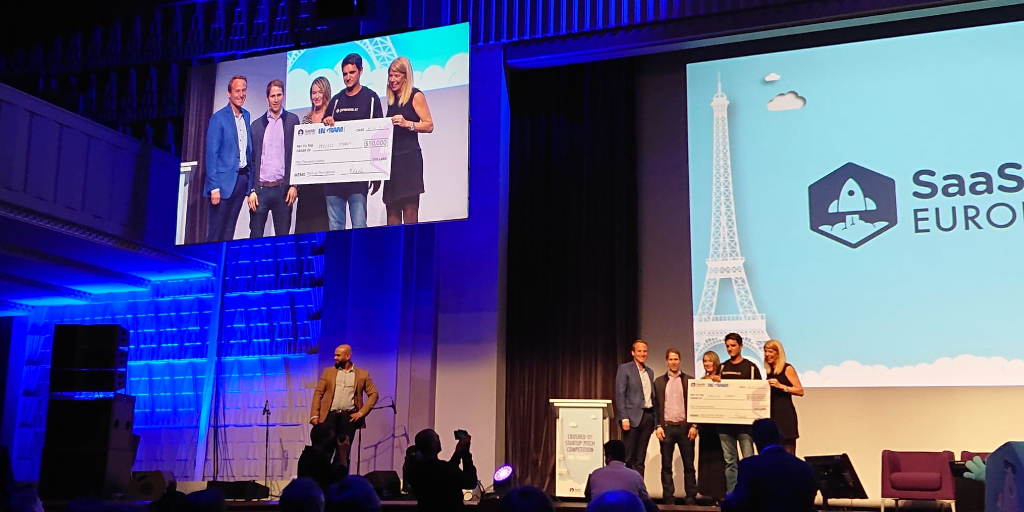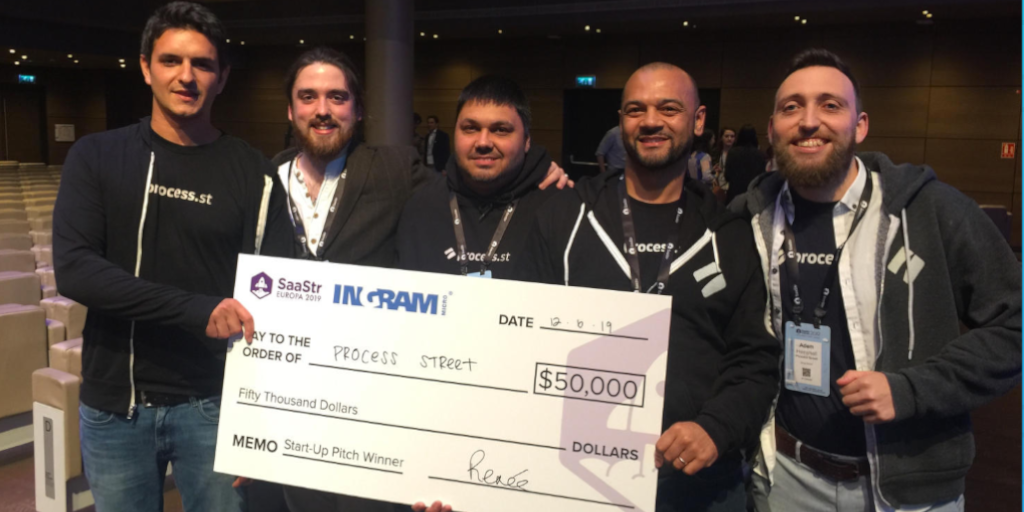
When your average pitch is worth $5,800 per second you can’t afford to get things wrong.
You have an average of 3 minutes and 44 seconds to convince potential investors that your business potential is worth their money.
Oh, and that you know what on Earth you’re doing.
That’s a lot of pressure for any business owner. So, we here at Process Street have taken our own experience pitching to 2,500+ investors, venture capitalists, and business owners to give you the ideal formula for creating a winning pitch deck.
We’ll be covering:
- What is a pitch deck?
- How to make a pitch deck
- Why should you believe this works?
- Pitch deck examples
Let’s get started!
What is a pitch deck?
A pitch deck is a presentation that lets you quickly show your business plan and potential to others. Your audience can be anything from potential investors to prospective co-founders, partners, and so on.
Despite targeting these various audiences, pitch decks don’t typically change in how you approach selling your business (or at least the idea of it).
Whether you’re pitching investors or potential partners, your goal is the same. You need to convince them of the value of your business, reassure them that you’ve got room to grow, a good plan and team to back up your potential, and generally alleviate their fears.
However, you won’t be doing this entirely with your pitch deck presentation alone.

Pitch decks aren’t used in a vacuum – you’ll be talking through extra information as you go and (usually) fielding a Q&A session to clear up any remaining issues. To that end, your pitch deck needs to be accompanied by a script for you to follow.
However, preparation isn’t everything. All of the showy stats in the world won’t do you any good if your audience loses interest, which typically happens at just before the 4-minute mark.
In other words, a pitch deck is a presentation to get you through the most valuable 3 minutes 44 seconds of your life.
How to make a pitch deck
As covered in our article How to Pitch Your Company and Land Investors, there are a couple of core questions that your pitch deck needs to answer in order to be successful.
- What’s the problem you target?
- Who are you?
- How do you solve it?
- Why you?
- Why now?
- What’s your expertise?
- What concrete success/growth have you had?
- Do you have any social proof?
- What’s your competition?
- How are you going to expand further?
If you can’t answer at least all of these questions in your time slot (again, this is typically around three minutes) then don’t add anything else. Instead, read through your work to see if there’s a more efficient way to answer all of these questions.
Most of these questions are very self-explanatory, and so can be answered in a couple of sentences. In fact, you have to do this for the majority of them if you want to stay under time.
By answering these questions you’re demonstrating a couple of key things to potential investors. Namely:
- What the premise of your business is
- What your growth potential is
- Why they should trust you with their money
- What sets you apart from your competition
- What audience you currently have
- What your current audience thinks of you
- How you’re dealing with competition
- How you will keep up your growth rate
If you’re ever unsure as to what details to include in your answers to the questions above, just think about whether what you’re saying shows any of these concepts.
If it doesn’t, cut it. You have to be ruthless with what you include, otherwise you’ll lose your shot.
Let’s say that you’re a company selling business process management software, and you’re explaining the problem you target. You sum it up with the basic details in a couple of sentences and a single slide (if you’re using a presentation). Something like:
“Business processes are broken. Most teams are using nothing, Word or Excel, or an older workflow product, leading to process lag and decay.”
It might be tempting to go into more detail over the other options teams use or the many ways that processes benefit the teams that use them. You could go on about how, while 96% of companies document their processes, only 4% measure and manage them.
The thing is, you don’t need to.
You’ve already given a sense of the scope of the issue, described what it is, and highlighted what the consequences of it are. Any more would be time better spent on something else, so don’t overstuff your explanation.
Why should you believe this works?
I know as well as anyone the difference between telling someone how to do something and actually carrying out those instructions. It comes with the territory of being in such a process-driven team where mistakes are traced back to the process checklist, rather than a specific person.
That’s why we tested this precise format out in front of over 2,500 business owners, investors, and venture capitalists at SaaStr Europa 2019.
The event was breathtaking.
Hosted in Paris in the Maison de la Mutualité, SaaStr Europa 2019 kicked things off in style with champagne and an inspiring introductory lecture. Following that was a solid two days of talks from industry leaders, CEOs, venture capitalists and more.
Amidst the networking, lectures, lunchtime walks past the stunning Notre Dame, and one-on-one sessions with other SaaS figures was a pitch competition.
Judged by Jason Lemkin, Renee Bergeron, Alex Kayyal and Ashley Smith, and with over 500 entrants, the four finalists (including us) had to make their pitch in front of the entire crowded theatre, getting live feedback from the judges and being up for any of the following prizes:
- $50,000 for the company Most Likely to Become a Unicorn
- $25,000 for Best Strategy + Vision
- $25,000 for Best Team
- A sponsorship at SaaStr 2020 for the audience’s favorite
Not only that, but we were told shortly before going on that we only had three minutes to make our presentation instead of the standard five.
In other words, our system and pitch deck was put under some of the highest and most public pressure possible.
Despite all of that, the presentation went incredibly well.
Our CEO Vinay Patankar covered all of our material concisely and managed to reach the end before the three-minute mark. We were actually the only team to achieve this, even if it did mean that one of the only pieces of feedback we had was to talk a little more slowly.

We won the Most Likely to Become a Unicorn award, netting a cool $50k for our company, and very nearly walked away with the SaaStr 2020 sponsorship from the audience award.
Turns out, no matter how good your pitch, sometimes you just can’t compete in a popular vote with a healthcare app letting doctors share advice and treat patients cheaper, faster, and more effectively.
Good-natured ribbing aside, Tonic App truly did have an equally fantastic pitch deck which followed much the same formula as our own!
Still, what’s the big deal?
Yes, we won a prize for our pitch, but the prize money alone was relatively small compared to the value of most investor pitches.
Well, our pitch meant that we didn’t just walk away with a $50k cheque.

After the event was over and things were wrapping up for the day, we swapped contact details with some of the judges and several event attendees. We essentially got an in with an audience that would otherwise have been incredibly difficult to cold pitch.
We even got a few new customers out of the event, which helped as a base to talk with other businesses present the following day.
In other words, we know it works because we’ve run it through the gauntlet and come out shining.
Pitch deck examples
Now that you know what makes a good pitch deck, let’s show off a few examples and go into what they do well, what they don’t, and generally show you how real-life companies build their pitches.
Process Street – grand prize winner at SaaStr Europa 2019
While I’ve already been through the context of this example in-depth, this pitch deck from our very own company Process Street was presented at SaaStr Europa 2019 to a crowd of 2,500+ CEOs, investors, VCs, industry leaders, and other professionals.
This is a fairly basic presentation that served as a core which our CEO could expand on through his script. However, this simplicity helped us to stand out from the competition and convey everything that we needed to.
Combined with our sleek design and custom animations, Process Street was able to walk away with the $50,000 grand prize from the competition, along with the contact details of several high profile investors, VCs, and even some extra customers from the crowd.
After receiving $500,000 from Peter Thiel (the first outside investor in Facebook back in 2004), Mark Zuckerberg and Eduardo Saverin were finally able to start turning Facebook into a long-term business.
However, they didn’t go into their investor meeting with a pitch as such. Instead, they had a media kit which they used as their pitch deck.
For our purposes, it was functionally the same thing.
The main thing to note when looking through this pitch deck is that Facebook (or “The Facebook” as it was back then) hadn’t proven itself on a business front. They were still working out how to make it profitable, with the main idea being to use it to sell advertisements.
This is why it focuses so much on the figures that they could show. Namely, their user, engagement, and audience statistics to demonstrate the scope of their business, the speed at which it had already grown, and the potential it had to grow further.
The social proof to top it all off is also vital here, as Facebook depends entirely on it being an attractive and addictive platform for its users. If said users are skipping their education just to stare at Facebook, you can definitely say that that’s proof of concept.
One final thing to note is that the presentation above isn’t actually the original slide deck. The original was captured here and then re-created with the same information here.
Airbnb
Airbnb is perhaps one of the biggest startup success stories. Being valued at $31 billion and having raised $3 billion from investors, they knew full well what they were doing when they went to pitch their business idea for the first time.
Wouldn’t you know it, their pitch still follows the basic principles we set out above.
While bearing in mind that this is a recreation of their initial pitch from a collection of screenshots (some of which the small text can’t be made out on), you can immediately tell that Airbnb was banking on the strength of their idea from the get-go.
The sell of its premise is immediate; people want to pay less for their trips and hotels don’t give you the authentic local experience. However, there wasn’t an easy way to book a room with a local or advertise as a local host.
They then immediately go on to demonstrate the market interest in this kind of idea, showing hard statistics for the number of trips booked per year, the customer base of similar competitors such as Couchsurfing and so on.
Airbnb doesn’t stop though, quickly moving on to show how they plan to capitalize on this market and where they stand in relation to their competition. This would be via targeting events every month, partnering with cheap and alternative travel, etc, and being the cheapest and most online-friendly solution on the market, respectively.
To cap it all off, their business plan is set out as clearly and simply as possible. With a 10% commission on bookings, Airbnb showed that it had a massive potential to take advantage of the gap in the market.
Aside from neglecting to mention their team (which could have been there originally but not recorded), this is an incredibly solid pitch, paving the way for Airbnb to become a true powerhouse in the holiday industry.
Systemize your success with Process Street
Pitch decks don’t have to be created very often (usually only during each investment round) but even then we’ve shown you how important it is to follow a tried-and-tested process to perform as well as you possibly can.
Now imagine applying that same care and practice to your regular processes. That’s where Process Street comes in.
Process Street is a leading piece of business process management software which lets you document your regular processes and run them as super-powered checklists.
These process templates let you give your team detailed instructions for how to complete their tasks each and every time, no matter how senior or junior the person performing them is. Nothing can be misunderstood and nothing gets missed.
With powerful features ranging from image and video embeds, scheduling checklists to automatically run and process automation, to conditional logic and an inbox to track all of the checklists you’re assigned to, it’s never been easier to carry out your tasks to the highest standard you possibly can.
If you’re more of a manager, we have an overview tab to easily see all of the checklists running from a particular process, task and role assignments to make sure that everyone is automatically (and dynamically) assigned to their duties, and a checklist exporting feature. You can also control the permissions of your team members to make sure that everyone can only see what you want them to see, protecting your sensitive processes from prying eyes.
To cap it all off, you can sign up for free!
Once you’re signed up, you can use any of our premade process templates to start off with a fully fleshed out sample process for anything from employee onboarding to marketing. These can be freely edited to your needs too.
If you need a little help we even have a collection of webinars on how to make the most out of Process Street!
Don’t let your pitch success go to waste with bad business processes. Give Process Street a try today and never look back.
Are there any pitch decks you think knock it out of the park? Let us know in the comments below!







Ben Mulholland
Ben Mulholland is an Editor at Process Street, and winds down with a casual article or two on Mulholland Writing. Find him on Twitter here.